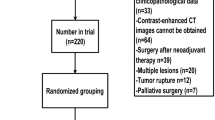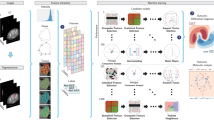Abstract
Purpose
Identify radiomics features associated with progression-free survival (PFS) and develop a predictive model for accurate PFS prediction in liver metastatic gastrointestinal stromal tumor patients (GIST).
Methods
This multi-center retrospective study involved a comprehensive review of clinical and imaging data pertaining to 211 patients with gastrointestinal stromal tumors (GIST) from Center A and B. A total of 147 patients with hepatic metastatic GIST were included, with 102 cases as the training set and 45 cases as the external validation set. Radiomics features were extracted from non-enhanced MR images, specifically T2WI, DWI, and ADC, and relevant features were selected through LASSO-Cox regression. A radiomics nomogram model was then constructed using multivariable Cox regression analysis to effectively predict PFS. The models performance were evaluated with the concordance index (C-index).
Results
The median age of the patients was 53 years, with 82 males and 65 females. A total of 21 radiomics features were selected to generate the radiomics signature. Radiomics signature slightly outperformed the clinical model but without significant difference (P > 0.05). Integrated radiomics signature with clinical features to build a nomogram, which exhibited high predictive performance in both training (C-index 0.757, 95% CI 0.692–0.822) and validation cohorts (C-index 0.718, 95% CI 0.618–0.818). Nomogram significantly outperformed the clinical model (P = 0.002 for training cohort, P < 0.001 for validation cohort). Stable long-term predictions shown by time-dependent ROC analysis (AUC 0.765–0.919 in training, 0.766–0.893 in validation). Multivariable Cox regression confirmed radiomics signature as an independent prognostic factor for preoperative survival prediction in hepatic metastatic GIST patients (HR = 3.973).
Conclusion
Radiomics signature is valuable for predicting PFS in metastatic GIST patients. Integrating imaging features and clinical factors into a comprehensive nomogram improves accuracy and effectiveness of survival prognosis, guiding personalized treatment strategies.
Graphical abstract






Similar content being viewed by others
References
Naito Y, Nishida T, Doi T. Current status of and future prospects for the treatment of unresectable or metastatic gastrointestinal stromal tumours. Gastric cancer : official journal of the International Gastric Cancer Association and the Japanese Gastric Cancer Association, 2023, 26(3): 339-51.
Blay J Y, Kang Y K, Nishida T, et al. Gastrointestinal stromal tumours. Nat Rev Dis Primers, 2021, 7(1): 22.
Klug L R, Khosroyani H M, Kent J D, et al. New treatment strategies for advanced-stage gastrointestinal stromal tumours. Nature reviews Clinical oncology, 2022, 19(5): 328-41.
Yu X, Liang X, Wen K. Clinical characteristics and prognosis of gastrointestinal stromal tumors with rare site metastasis (Review). Oncology letters, 2022, 24(6): 453.
Kelly C M, Gutierrez Sainz L, Chi P. The management of metastatic GIST: current standard and investigational therapeutics. J Hematol Oncol, 2021, 14(1): 2.
Demetri G D, Von Mehren M, Blanke C D, et al. Efficacy and safety of imatinib mesylate in advanced gastrointestinal stromal tumors. The New England journal of medicine, 2002, 347(7): 472-80.
Heinrich M C, Corless C L, Demetri G D, et al. Kinase mutations and imatinib response in patients with metastatic gastrointestinal stromal tumor. J Clin Oncol, 2003, 21(23): 4342-9.
Demetri G D, Reichardt P, Kang Y K, et al. Efficacy and safety of regorafenib for advanced gastrointestinal stromal tumours after failure of imatinib and sunitinib (GRID): an international, multicentre, randomised, placebo-controlled, phase 3 trial. Lancet (London, England), 2013, 381(9863): 295-302.
Mao X, Yang X, Chen X, et al. Single-cell transcriptome analysis revealed the heterogeneity and microenvironment of gastrointestinal stromal tumors. Cancer Sci, 2021, 112(3): 1262-74.
Casali P G, Abecassis N, Aro H T, et al. Gastrointestinal stromal tumours: ESMO-EURACAN Clinical Practice Guidelines for diagnosis, treatment and follow-up. Ann Oncol, 2018, 29(Suppl 4): iv68-iv78.
Von Mehren M, Kane J M, Riedel R F, et al. NCCN Guidelines® Insights: Gastrointestinal Stromal Tumors, Version 2.2022. Journal of the National Comprehensive Cancer Network : JNCCN, 2022, 20(11): 1204-14.
Von Mehren M, Kane J M, Bui M M, et al. NCCN Guidelines Insights: Soft Tissue Sarcoma, Version 1.2021. Journal of the National Comprehensive Cancer Network : JNCCN, 2020, 18(12): 1604-12.
Smith-Bindman R, Lipson J, Marcus R, et al. Radiation dose associated with common computed tomography examinations and the associated lifetime attributable risk of cancer. Archives of internal medicine, 2009, 169(22): 2078-86.
Zheng T, Du J, Yang L, et al. Evaluation of risk classifications for gastrointestinal stromal tumor using multi-parameter Magnetic Resonance analysis. Abdominal radiology (New York), 2021, 46(4): 1506-18.
Lambin P, Rios-Velazquez E, Leijenaar R, et al. Radiomics: extracting more information from medical images using advanced feature analysis. European journal of cancer (Oxford, England : 1990), 2012, 48(4): 441-6.
Mayerhoefer M E, Materka A, Langs G, et al. Introduction to Radiomics. Journal of nuclear medicine : official publication, Society of Nuclear Medicine, 2020, 61(4): 488-95.
Kong C, Zhao Z, Chen W, et al. Prediction of tumor response via a pretreatment MRI radiomics-based nomogram in HCC treated with TACE. European radiology, 2021, 31(10): 7500-11.
Wang T, She Y, Yang Y, et al. Radiomics for Survival Risk Stratification of Clinical and Pathologic Stage IA Pure-Solid Non-Small Cell Lung Cancer. Radiology, 2022, 302(2): 425-34.
Feng Z, Li H, Liu Q, et al. CT Radiomics to Predict Macrotrabecular-Massive Subtype and Immune Status in Hepatocellular Carcinoma. Radiology, 2023, 307(1): e221291.
Lin J X, Wang F H, Wang Z K, et al. Prediction of the mitotic index and preoperative risk stratification of gastrointestinal stromal tumors with CT radiomic features. Radiol Med, 2023.
Wang M, Feng Z, Zhou L, et al. Computed-Tomography-Based Radiomics Model for Predicting the Malignant Potential of Gastrointestinal Stromal Tumors Preoperatively: A Multi-Classifier and Multicenter Study. Frontiers in oncology, 2021, 11: 582847.
Eisenhauer E A, Therasse P, Bogaerts J, et al. New response evaluation criteria in solid tumours: revised RECIST guideline (version 1.1). European journal of cancer (Oxford, England : 1990), 2009, 45(2): 228-47.
Koo T K, Li M Y. A Guideline of Selecting and Reporting Intraclass Correlation Coefficients for Reliability Research. Journal of chiropractic medicine, 2016, 15(2): 155-63.
Simon N, Friedman J, Hastie T, et al. Regularization Paths for Cox's Proportional Hazards Model via Coordinate Descent. J Stat Softw, 2011, 39(5): 1-13.
Yang L, Zheng T, Dong Y, et al. MRI Texture-Based Models for Predicting Mitotic Index and Risk Classification of Gastrointestinal Stromal Tumors. Journal of magnetic resonance imaging : JMRI, 2021, 53(4): 1054-65.
Zhao Y, Feng M, Wang M, et al. CT Radiomics for the Preoperative Prediction of Ki67 Index in Gastrointestinal Stromal Tumors: A Multi-Center Study. Frontiers in oncology, 2021, 11: 689136.
Zhang B, Luo C, Zhang X, et al. Integrative Scoring System for Survival Prediction in Patients With Locally Advanced Nasopharyngeal Carcinoma: A Retrospective Multicenter Study. JCO Clin Cancer Inform, 2023, 7: e2200015.
Yan J, Zhang B, Zhang S, et al. Quantitative MRI-based radiomics for noninvasively predicting molecular subtypes and survival in glioma patients. NPJ Precis Oncol, 2021, 5(1): 72.
Chang Y R, Huang W K, Wang S Y, et al. A Nomogram Predicting Progression Free Survival in Patients with Gastrointestinal Stromal Tumor Receiving Sunitinib: Incorporating Pre-Treatment and Post-Treatment Parameters. Cancers (Basel), 2021, 13(11).
Consolino L, Longo D L, Sciortino M, et al. Assessing tumor vascularization as a potential biomarker of imatinib resistance in gastrointestinal stromal tumors by dynamic contrast-enhanced magnetic resonance imaging. Gastric cancer : official journal of the International Gastric Cancer Association and the Japanese Gastric Cancer Association, 2017, 20(4): 629-39.
Stroszczynski C, Jost D, Reichardt P, et al. Follow-up of gastro-intestinal stromal tumours (GIST) during treatment with imatinib mesylate by abdominal MRI. European radiology, 2005, 15(12): 2448-56.
Yu M H, Lee J M, Baek J H, et al. MRI features of gastrointestinal stromal tumors. AJR Am J Roentgenol, 2014, 203(5): 980-91.
Zhou H Y, Zhang X M, Zeng N L, et al. Use of conventional MR imaging and diffusion-weighted imaging for evaluating the risk grade of gastrointestinal stromal tumors. Journal of magnetic resonance imaging : JMRI, 2012, 36(6): 1395-401.
Kang T W, Kim S H, Jang K M, et al. Gastrointestinal stromal tumours: correlation of modified NIH risk stratification with diffusion-weighted MR imaging as an imaging biomarker. European journal of radiology, 2015, 84(1): 33-40.
Fu J, Fang M J, Dong D, et al. Heterogeneity of metastatic gastrointestinal stromal tumor on texture analysis: DWI texture as potential biomarker of overall survival. European journal of radiology, 2020, 125: 108825.
Ekert K, Hinterleitner C, Horger M. Prognosis assessment in metastatic gastrointestinal stromal tumors treated with tyrosine kinase inhibitors based on CT-texture analysis. European journal of radiology, 2019, 116: 98-105.
Yeh C N, Chen Y Y, Tseng J H, et al. Imatinib Mesylate for Patients with Recurrent or Metastatic Gastrointestinal Stromal Tumors Expressing KIT: A Decade Experience from Taiwan. Transl Oncol, 2011, 4(6): 328-35.
Dematteo R P, Ballman K V, Antonescu C R, et al. Adjuvant imatinib mesylate after resection of localised, primary gastrointestinal stromal tumour: a randomised, double-blind, placebo-controlled trial. Lancet (London, England), 2009, 373(9669): 1097-104.
Kim J H, Lee Y C, Kim H, et al. Additive lymph node dissection may be necessary in minute submucosal cancer of the stomach after endoscopic resection. Annals of surgical oncology, 2012, 19(3): 779-85.
Miettinen M, Lasota J. Gastrointestinal stromal tumors: pathology and prognosis at different sites. Seminars in diagnostic pathology, 2006, 23(2): 70-83.
Heinrich M C, Owzar K, Corless C L, et al. Correlation of kinase genotype and clinical outcome in the North American Intergroup Phase III Trial of imatinib mesylate for treatment of advanced gastrointestinal stromal tumor: CALGB 150105 Study by Cancer and Leukemia Group B and Southwest Oncology Group. J Clin Oncol, 2008, 26(33): 5360-7.
Shafiq-ul-Hassan M, Zhang G G, Latifi K, et al. Intrinsic dependencies of CT radiomic features on voxel size and number of gray levels. Medical physics, 2017, 44(3): 1050-62.
Kociołek M, Strzelecki M, Obuchowicz R. Does image normalization and intensity resolution impact texture classification?. Computerized medical imaging and graphics : the official journal of the Computerized Medical Imaging Society, 2020, 81: 101716.
Acknowledgements
This research was supported by Qinhuangdao Key Research and Development of Science and Technology Support Project (202301A272).
Author information
Authors and Affiliations
Contributions
TZ, DL and YF designed and coordinated the study, LY and DZ carried out experiment and data process, and drafted the manuscript. All authors gave final approval for publication.
Corresponding authors
Ethics declarations
Conflict of interest
The authors declare that the research was conducted in the absence of any commercial or financial relationships that could be construed as a potential conflict of interest.
Ethical approval
This retrospective study involved human participants. This retrospective study that incorporates anonymous data was approved by the Ethics Committee of two hospitals and the need for informed consent was waived.
Additional information
Publisher's Note
Springer Nature remains neutral with regard to jurisdictional claims in published maps and institutional affiliations.
Supplementary Information
Below is the link to the electronic supplementary material.
Rights and permissions
Springer Nature or its licensor (e.g. a society or other partner) holds exclusive rights to this article under a publishing agreement with the author(s) or other rightsholder(s); author self-archiving of the accepted manuscript version of this article is solely governed by the terms of such publishing agreement and applicable law.
About this article
Cite this article
Yang, L., Zhang, D., Zheng, T. et al. Predicting the progression-free survival of gastrointestinal stromal tumors after imatinib therapy through multi-sequence magnetic resonance imaging. Abdom Radiol 49, 801–813 (2024). https://doi.org/10.1007/s00261-023-04093-8
Received:
Revised:
Accepted:
Published:
Issue Date:
DOI: https://doi.org/10.1007/s00261-023-04093-8




